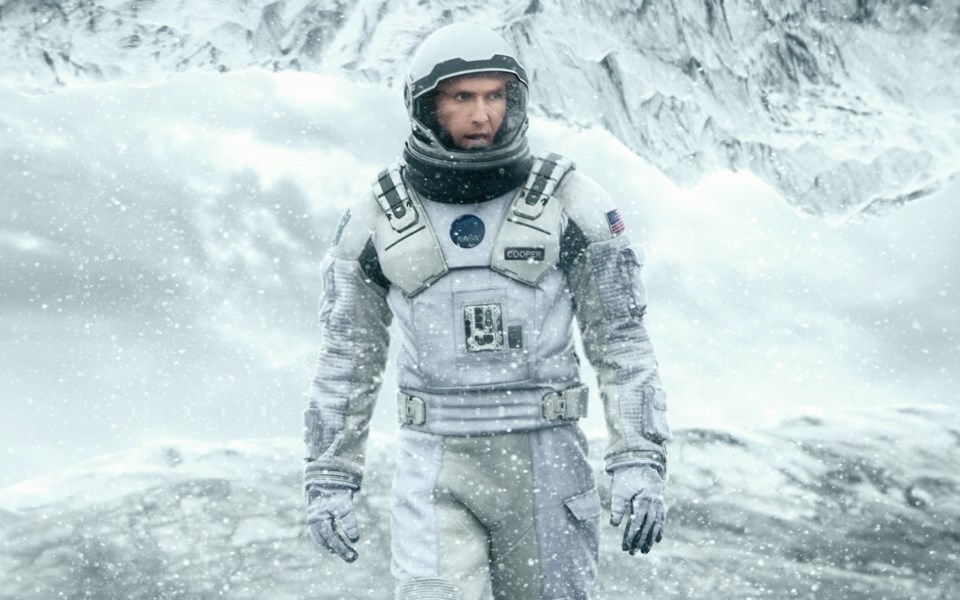In Interstellar’s scary real-world scenario, humankind has wreaked so much havoc on the Earth that crops have failed and the population has dwindled drastically. In the U.S., corn is officially the only viable crop left to feed the masses, but it too is falling victim to blight that has turned the soil to dust. It’s like The Grapes of Wrath redux: dust covers everything, towering dust storms envelop towns and people are slowly suffocating.
Cooper (Matthew McConaughey) has done alright (or is that “alright, alright, alright”?) so far. He’s a corn farmer, a widower scratching out a survival with two kids and his father-in-law (John Lithgow) at home. Cooper resents the fact that school officials have decreed his son will also become a farmer, and is incensed that his 10-year-old daughter Murphy’s textbooks have been rewritten to declare the Apollo landings bogus. “We used to look and wonder about our place in the stars,” laments Coop, “Now we just look down in the dirt.”
Cooper has reason to reminisce: he used to be a pilot for NASA. Imagine the coincidence, then, when Cooper and Murph stumble upon a top-secret NORAD facility run by his old mentor, Professor Brand (Michael Caine). Of course, there are no coincidences, the film suggests. Brand and his team have found a wormhole leading to 12 possibly viable worlds: they’ve already sent manned craft to several of the planets — the Lazarus missions — and receive vague signals from a few. It’s up to the crew to try to reach the most promising planets and A, send data back to Earth so humankind can head for their new planetary home, or B, leave Earth’s population to die while the crew establishes a new colony with the few hundred frozen embryos they’ve brought onboard.
Cooper has now joined the expedition and is strongly for option A, being a father with strong ties back home. Murph begs him not to go: it was some kind of ghostly, binary code in her bedroom that led them to the NORAD facility in the first place and now, she insists, it’s telling Coop to stay.
But go he does, with Brand’s scientist daughter Amelia (Anne Hathaway) and two other crew members (David Gyasi and Wes Bentley) onboard. It’s a race against time: for every hour the crew spends on one of these planets, seven years will have passed on Earth. Time is a tricky thing.
Meanwhile Brand and Jessica Chastain try to solve the gravity equation that will allow for a planetary exodus. Casey Affleck has taken over Coop’s farm.
McConaughey conveys a father’s anguish perfectly. Hathaway is less convincing; granted, her character is less fully formed and director Christopher Nolan’s script, written with brother Jonathan, takes a backseat to the spectacle at hand.
The film was shot using a combination of 35mm and 65mm Imax technology, and this is where it pays off: the sound of space craft takeoff and landing is deafening and seat-rattling; the silence of space is striking. Hans Zimmer’s score has just the right mix of awe and menace, so we never know what’s about to happen. Visually, Interstellar is an impressive, immersive experience, and as we hurtle from one near-disaster to the next we hardly notice the film’s two-hour and 49 minute runtime. For two-thirds of the movie, that is.
Because none of us knows what it’s like on the far side of a worm hole, the last third of the film necessarily takes on a trippy, Kubrickian turn and our attention begins to falter. The fourth and fifth dimension, the scientific purpose of love, bending time: pair these with the film’s last-act strangeness and many viewers will leave scratching their heads and wishing they had gone to an Adam Sandler movie instead.
Interstellar screens at Dunbar, Scotiabank and the Park Theatre.



